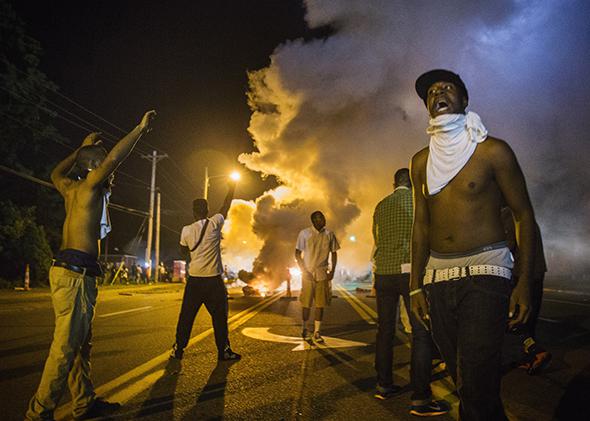FERGUSON, Mo.—Talk to anyone in Ferguson and you’ll hear a story about the police. “One of my friends had a son killed by the Ferguson Police Department, about 10 years ago,” said Carl Walker, a Vietnam veteran and former parole officer who came to show his support for demonstrators in Ferguson. “They wouldn’t release the name of the officer who killed him. Why wouldn’t you release the name?”
“The cops said he shot at them—case closed,” said Al Cole, referring to a cousin who was killed by Ferguson police in 2000. “Even as a teenager, 13 or 14 years old, I’ve been slammed on police cars … now I try to avoid riding through Ferguson.”
“Some police say they saw me at a house, pulled me, said I fit a description, locked me up, and found out I was on parole,” said Craig Beck, who was watching demonstrators under the shade of a burned-out QuikTrip convenience store. “They said I threw a plastic baggie, which they didn’t have when they took me into custody.” He continues: “I beat the case, but you know, this isn’t new. This happens every day.”
Everyone—or at least, every black person—can recall an incident. Everyone can attest to friends and relatives who have been harassed, assaulted, or worse by the police.
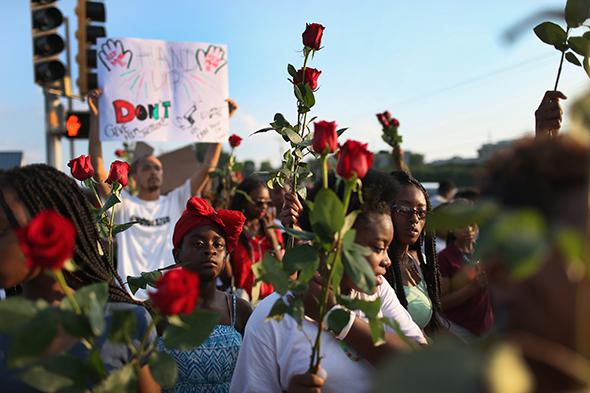
Photo by Joe Raedle/Getty Images
Perhaps one of the most disturbing cases was last year’s shooting of Cary Ball Jr., a 25-year-old black student at St. Louis Community College–Forest Park. The official police report is that Ball crashed his car after a high-speed chase, ran away, and aimed his weapon at officers after they confronted him. Witnesses say Ball had thrown his gun to the ground and was walking toward police—hands up—when he was shot and killed with 25 rounds. A federal investigation cleared the officers. Likewise, that February, surveillance video from a casino showed St. Louis police slamming a black man’s head into the bumper of a vehicle, after a dispute over gambling and trespassing. And in March of this year, a video showed St. Louis police officers beating a mentally disabled man in his home, after the family called police for help.
These weren’t isolated events. A 2012 report from University of Missouri–St. Louis criminologist David Klinger found that, from 2008 to 2011, St. Louis police officers fired their weapons 98 times. “Any comparison across cities right now is still missing the lion’s share of circumstances in which people are shot by the police,” Klinger said to the St. Louis Post-Dispatch. “There are only a smattering of cities that report their officer-involved shootings, and when compared against them, St. Louis is on the high end.” The data on police violence is incomplete, as there is no federal effort to pull together information on unjustified homicides. But the anecdotes of brutality and excessive force out of St. Louis and St. Louis County are rampant and often startling. In 2009, for example, a man was wrongly arrested, beaten by police, and subsequently charged for bleeding on their uniforms.
This abuse is so ubiquitous that the shooting of Michael Brown might seem like static against a backdrop of awfulness. But even for the area, Brown’s death was brutal. Which is why—in an otherwise quiet town in an otherwise quiet area—we’re dealing with an explosive fire that shows no signs of ending.

Photo by Lucas Jackson/Reuters
By now, if you’ve followed the news, you know the story has two sides.
Police say Brown resisted arrest and assaulted an officer. “The genesis of this was a physical confrontation,” said St. Louis County police Chief Jon Belmar during a press conference after the shooting. In the official narrative, a routine stop turned into a struggle with two men, Brown and his friend. As officer Darren Wilson tried to leave his vehicle, one of the two pushed him back into the car and lunged for his gun. During the struggle, one shot was fired, and soon after, Brown was shot multiple times on the street.
To the eyewitnesses, this story is nonsense. Dorian Johnson was with Brown at the time of the encounter. He was the “other man.” In his account, the two were walking down the middle of the street, having a conversation, when Wilson—the shooter—drove down and told them to “get the f–k off the street.” They continued, he drove off, and a few seconds later, he reversed his car in their direction and opened the door. As Johnson describes it, “He was so close to us that [the door] … bounced back toward him. At that point, he reached out the window and tried to choke my friend. We were trying to get away, and he tried to pull my friend into the car.” A few moments later, Wilson pulled out his gun and shot Brown, injuring him. “We look at [Brown], he was shot and there was blood comin’ from him. … We took off running, and I hid because I feared for my life. My friend took off running, too,” explained Johnson.
Wilson then stepped out of the car, weapon drawn, and shot again. “Once my friend felt that, he put his arms in the air, and he started to get down, but the officer still approached with the weapon drawn, and he fired several more shots, and my friend died. He didn’t say anything to him, he just stood over him and kept shooting.” Another witness described a similar scene. “I know he shot that child, and when he shot him, the little boy fell, then he shot him six more times,” said one woman in an interview with local newscasters.
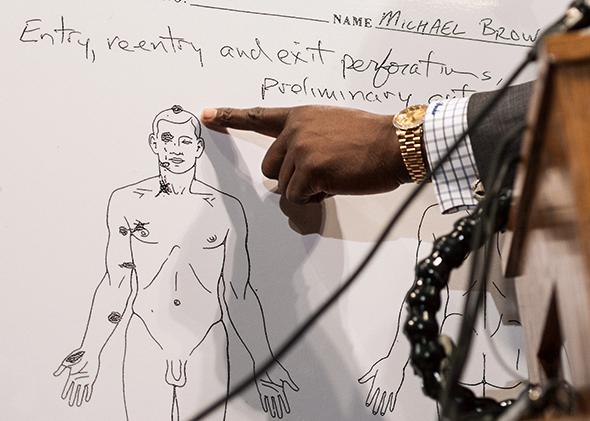
Photo by Mark Kauzlarich/Reuters
To residents of Ferguson, in other words, the situation is simple. Michael Brown was executed by an angry cop. You can hear their shock and fear in a video recorded just after the shooting. “They killed him for no reason … they just killed this n—er for no reason,” said one man. “Do you see a knife? Do you see anything that would have caused a threat to these motherf–kin’ police? They shot that boy because they wanted to shoot that boy in the middle of the motherf–kin’ day in the middle of the motherf–kin’ street.”
A forthright police department could have calmed these nerves. They could have answered basic questions: Who was the shooter? How many times did he fire? What was Brown stopped for? And why did officers let his body sit in the street for four hours?
Instead, led by Chief Thomas Jackson, the Ferguson Police Department stonewalled at every turn, refusing cooperation and transparency. And when residents began to gather near the site of Brown’s shooting to demonstrate and memorialize, police responded with guns and dogs, sparking a cycle of protest and repression. Nightly demonstrations from residents were met with tear gas and rubber bullets by aggressive, militarized police, which sparked larger, more aggressive demonstrations and harsher, more draconian responses, justified by reports of looting and violence. After an especially bad night of clashes on Sunday, Missouri Gov. Jay Nixon sent the National Guard to Ferguson to attempt to keep the peace.
Given frustrated residents and a recalcitrant Ferguson Police Department—which has yet to release its autopsy report—it’s hard to know if calm is possible. Insofar that there’s new information, it’s from a private autopsy report, released on Sunday, which shows Brown was shot at least six times, including twice in the head. And on Monday, demonstrations took another turn for the worst, as police fired tear gas into crowds, and a handful of protesters returned fire with live rounds.
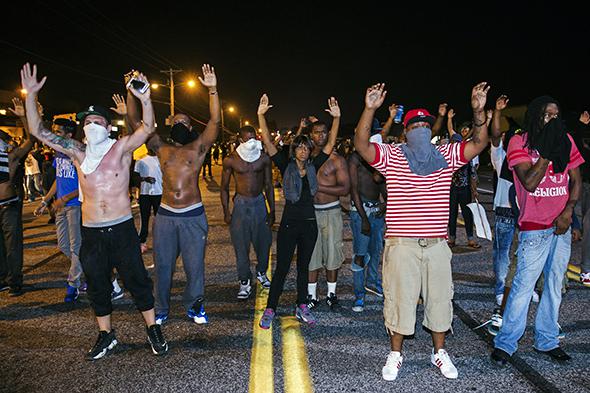
Photo by Lucas Jackson/Reuters
But while calm is hard to predict, one thing is clear: The events in Ferguson—from the shooting to the police response and everything since—are a product of familiar forces and stem from a familiar history. Put another way, the area’s long-bottled racial tension has burst, and it’s difficult to know if it can be resolved, much less contained.
Like many American cities, St. Louis can’t be untangled from segregation. In 1916, it became one of the first places to formalize racial segregation by designating particular “Negro blocks” where blacks would be concentrated and legally forbidden from leaving. The Supreme Court struck the ordinance in 1917, but private real estate agents and other groups responded with informal means of enforcing segregation. In 1923, the St. Louis Real Estate Exchange created zones in the city’s black neighborhoods to limit the extent of black housing. Real estate agents could sell to black families inside the zones, but would lose their licenses if they sold homes outside the zones.
In 1941—bolstered by federal housing discrimination—real estate agents combined these zones into a single district and adopted “racial covenants” that restricted or banned the sale of properties to black families outside of the district. As professor Colin Gordon of the University of Iowa wrote, “Both the City’s Real Estate Exchange and the Missouri Real Estate Commission routinely and openly interpreted sales to blacks in white areas as a form of professional misconduct,” and by the 1940s, “almost 380 covenants covered large and strategic swaths of the City’s residential property base.”
The G.I. Bill and the end of World War II sparked a massive move to the suburbs. Between 1950 and 1970, close to 60 percent of whites had moved to suburbs in the western parts of St. Louis County. Blacks —pushed by “urban renewal” and other policies—also moved, but restrictive covenants limited mobility to northern parts of the city and county.
As the area entered the 1980s, racial succession had taken hold, as blacks entered older, inner-ring suburbs and whites left for the far reaches of the county. Depopulation accelerated—the city of St. Louis lost more than a third of its residents—and the suburban “color line” had drifted to include most of the North County suburbs. “Ghetto spillover,” said one local, noted by Gordon, “now stretches almost all the way across the county in a northwesterly direction.” In 1990, Ferguson was 74 percent white and 25 percent black. Now, at 67 percent black and 29 percent white, it’s nearly reversed.
As of 2010, 42 years after Congress passed the Fair Housing Act, greater St. Louis was one of the most segregated areas in the United States. And segregation comes with a familiar set of problems. Middle-class neighborhoods—and thus middle-class services—are few and far between, with most wealth concentrated in the farther, whiter reaches of the county.
As the New America Foundation’s Dana Goldstein finds, the schools are in bad shape as well. Michael Brown attended Normandy High, where he was one of the 58 percent of students who graduated this year (compared with a statewide average of 80). In 2011, 98 percent of the 1,064 students at the school were black, and 74 percent were low-income. Most tellingly, 45 percent of Normandy students were suspended that year, and—given what we know about the area—there’s no question some were funneled into the criminal justice system.
With broad housing inequality and entrenched segregation, it shouldn’t be a shock to learn that banks targeted North County—and other predominantly black areas nationwide—with subprime loans. The result was a community hit hard by the 2008 recession. The unemployment rate for blacks there is three times as high as it is for whites, and among black men aged 16 to 24, the unemployment rate is a whopping 47 percent. This high inequality is exacerbated by intense sprawl, which separates low-income residents from potential jobs. Which is to say that the same patterns of housing segregation that impede black wealth in cities like Chicago and Detroit—which top the list of segregated cities—are also operative in St. Louis.

Photo by Bill Pugliano/Getty Images
“We’re continuously economically depressed, chronically unemployed, voter participation is typically low, and on any measure of health and viability, we would be at the bottom in the most deplorable ways,” said Etefia Umana, who sits on the board of Better Family Life, a local nonprofit, and hopes the Michael Brown demonstrations lead to broader social action.
All of these ills are made worse by the absence of black political and civic representation in many of the area’s 90 independent municipalities. For example, as has been widely reported, Ferguson has just one black city council member and three black police officers out of a force of 55. The mayor is white, the school superintendent is white, and the police chief is white. The disparity is easy to understand. “North County is becoming more transient, and you have a lot of people who are moving in temporarily and moving right out,” said Wesley Bell, a local law professor and prosecutor who ran for a seat on the St. Louis County Council this year. “Therefore, they may not get registered, they may not get involved in local politics if they’re just moving through.”
Moreover, as New School professor (and former St. Louis politician) Jeff Smith explained for the New York Times, overwhelmingly white labor organizations and other groups run effective get-out-the-vote operations, which bring thousands of voters to low-turnout elections and ensure white dominance in local political bodies. It also helps that area municipal elections are held in the spring, on off years, a Progressive-era election reform that dramatically lowers turnout. In the 2012 presidential elections, turnout for Ferguson blacks was 54 percent. The next year, in municipal elections, turnout had dropped to 6 percent.
An overbearing police presence is a defining feature of life in Ferguson and the rest of North County. Last year in Ferguson, 86 percent of stops, 92 percent of searches, and 93 percent of arrests involved blacks, despite the fact that police found more “contraband” stopping white residents than black ones. I spoke to several young men in Ferguson—all teenagers or in their early 20s—who said they were stopped on a weekly basis. At a makeshift Michael Brown memorial, I asked one 20-year-old how many times he’s stopped by police, “About 10 times a month,” he said.
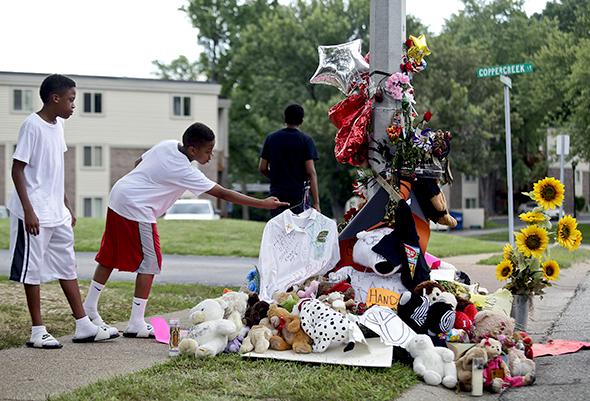
Photo by Joshua Lott/Reuters
Again, the forces in St. Louis are familiar. And when it comes to police, what we see in Ferguson is a microcosm of the long and contentious relationship of black Americans to law enforcement.
During the first Great Migration of blacks in the early 20th century, a nascent group of black academics, lawyers, and other professionals began to study and report police violence toward blacks, prompted by the growing use of crime statistics to justify urban segregation—like the kind we see in St. Louis.
“They saw police officers as a form of state authority, and the most consistent form of government interaction for African-Americans,” says Khalil Gibran Muhammad, director of the Schomburg Center for Research in Black Culture and author of The Condemnation of Blackness: Race, Crime, and the Making of Modern Urban America. For them, police weren’t civil servants as much as they were vectors for brutality, meant to isolate and contain black communities. “Blacks were the easiest targets of the police; their rights were the least respected, and they had only a modicum of political influence to hold officers accountable,” Muhammad wrote in his book. Criminality was well-distributed among the ethnic and racial groups of the North, but blacks were disproportionate targets for police. The result was a perception of black criminality despite the lack of clear evidence it actually existed.
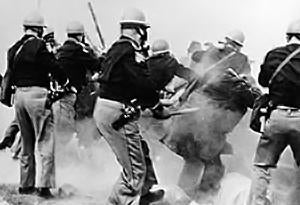
Alabama police attack Selma-to-Montgomery marchers on March 7, 1965.
Photo by FBI via Wikimedia Commons
That trend continued into the middle of the century. “African-Americans throughout the country confronted repressive police departments that were threatened by black demands for equality after World War II and intimidated by an expanded black populace as whites fled to the suburbs,” University of Texas professor Leonard N. Moore noted in Black Rage in New Orleans: Police Brutality and African American Activism From World War II to Hurricane Katrina. He continued: “[A] cursory examination of black newspapers in the postwar period reveals articles … detailing cases of police brutality. Likewise, the archives of local and national civil rights organizations are filled with thousands of affidavits and letters relaying first-person experiences of police brutality.”
One incident, the 1961 killing of 11-year-old Allen Bruce Foster in New Orleans, stands out for its brutality. As one witness described it, “I saw the child running toward a red automobile. Just as he reached it he was shaken violently as bullets tore into his body. The boy let out a piercing scream—one I shall never forget and fell to the ground. A policeman then stooped over the boy and said, ‘Why didn’t you stop when I told you to halt?’ The boy never answered, never moved. I never heard anyone tell the boy to halt.”
What’s important to understand is that these incidents and interactions reflect upon themselves. “Too often the policeman’s club is the only instrument of the law with which the Negro comes into contact,” wrote Howard University criminologist Kelly Miller in a 1935 op-ed. “This engenders in him a distrust and resentful attitude toward all public authorities and law officers.”
If you’re trying to grasp the looting that has struck Ferguson throughout the demonstrations, there’s some of your answer. For as much as there are bad apples and provocateurs in any mass gathering, it’s also true that there’s a deep distrust of law enforcement across the black community that stems from decades of unfair treatment. “That’s our life. We black. We get pulled over everyday,” said two young demonstrators who declined to give their names, but were adamant—as chants of “Hands up, don’t shoot” filled the air—that they were “out here for Michael Brown” and “they would do it however they [the police] wanted to do it.”
Perhaps the closest analogue to the Michael Brown shooting is the Trayvon Martin killing. Both were young men in their teens, and both sparked discussions of profiling and racism.
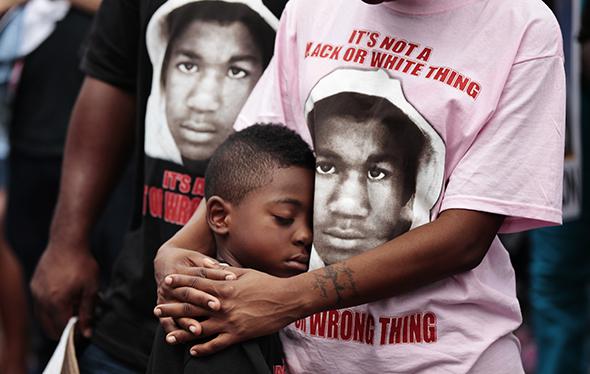
Photo by Lucas Jackson/Reuters
But there’s a key difference. Martin wasn’t killed by a police officer; his shooter was George Zimmerman, a neighbor. Which meant that, for supporters of Martin, there was a concrete goal and a clear hope: Bring Zimmerman to trial and hope he’s convicted. Zimmerman wasn’t convicted, but his trial brought a measure of closure to the situation.
It’s possible that Darren Wilson will also be arrested and go to trial. But even if he’s convicted—even if the Brown family finds a measure of procedural justice—we will still be left with an unequal, segregated Ferguson in an unequal, segregated St. Louis County. The underlying problems of white flight, discrimination, and disinvestment will remain, and—absent a dramatic and unexpected change—they’ll persist into the next generation. We may never see another “Trayvon Martin” in Sanford, Florida, but I’m positive we’ll see another “Michael Brown” in Ferguson, Missouri.
Or somewhere else. Soon enough, demonstrators will be chanting the name of another young black man killed by another agent of the state charged with containing blacks, not protecting them. We want it to be one way—a world where the police are here to serve us all—but it’s the other way, a world where black bodies are the chief targets of American fear.
On last Thursday, the scene West Florissant, the main site of the demonstrations, was jubilant. The streets were thick with people chanting slogans and demanding “justice,” while cars drove by honking in support. A gospel choir sang, and Capt. Ron Johnson—the Missouri Highway Patrol chief tasked with maintaining order—mingled with the crowd, going so far as to march with the demonstrators.
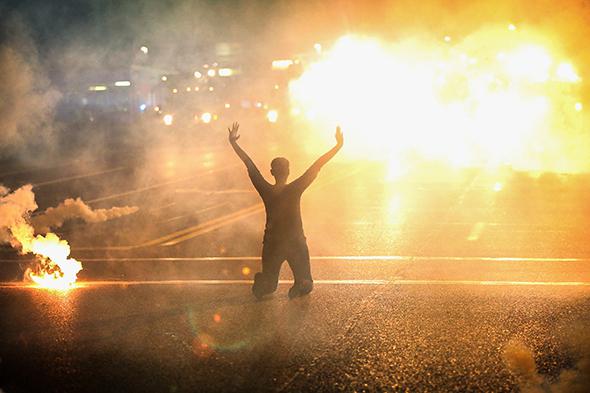
Photo by Scott Olson/Getty Images
By the next night, everything had fallen apart. Despite Johnson’s promise, police used tear gas against protesters, prompting more anger and more destruction.
On Sunday and Monday, the chaos repeated itself, with more gas and more rubber bullets. In all of the live streams and videos, one scene caught my eye. A mother stands with her son, who has just been hit with tear gas. He’s 8 years old.
